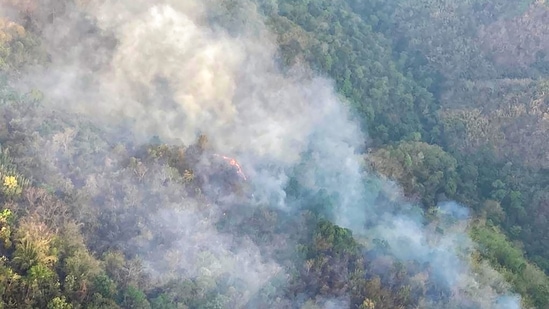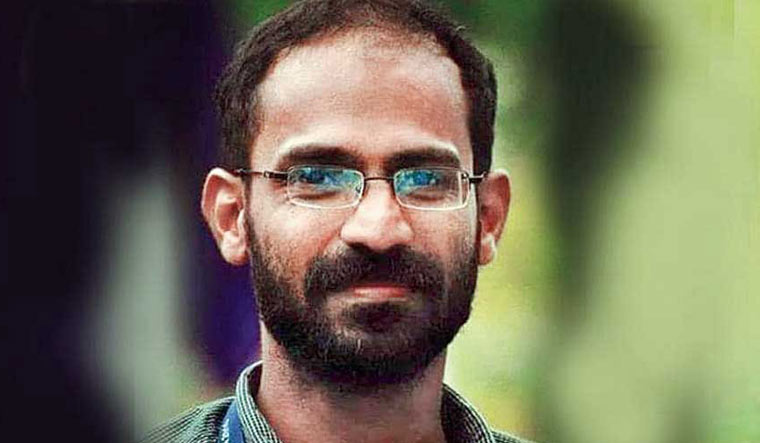TSLA made $100MM in 1 month of trading crypto, more than it ever made selling cars in 14 years (ex reg credits). It should shut all money losing ventures and become a full time trading desk.
Wall
Street expectations from TSLA's earnings today are rather stratospheric,
but as Bloomberg notes, even if the company misses big, the S&P 500
likely won’t be in the doldrums tomorrow because of it. Why? Simply
put, the electric-vehicle maker matters less than other high-profile
stocks in the broad market gauge.
Alphabet, Amazon.com, Apple,
Microsoft and Tesla are among the most influential companies in the
stock market. But by one simple measure, Tesla looks different than the
others. The S&P 500’s 30-day positive correlation with the stock has fallen to ~0.44 from an early March peak of almost 0.8. That
pales in comparison with Microsoft at ~0.77, Apple at ~0.72, Amazon at
~0.68 and Alphabet at ~0.65. In fact, the S&P 500’s correlation with
old-school cyclical Caterpillar -- which also reports this week -- is
higher than Tesla at ~0.51. This falling correlation is inevitable
as Tesla has gained less than 5% this year compared with over 11% for
the S&P 500, with value sectors such as energy and financials
outperforming. This has happened as meme stocks like GameStop have
pushed Tesla out of the limelight, while Bitcoin has attracted almost
all the buzz.
With that in mind, here is what TSLA reported shortly after the close for Q1:
- Adjusted EPS of 93C, beating est. 80c
- Revenue $10.389BN, missing est. $10.42 billion (range $8.20 billion to $12.34 billion)
- Free Cash Flow $293MM, beating est. of cash burn of $82.8 million
- Automotive gross margin +26.5%, beating est +24.3%
- Cash and cash equivalents $17.14 billion, missing estimates of $17.90 billion
The results visually:
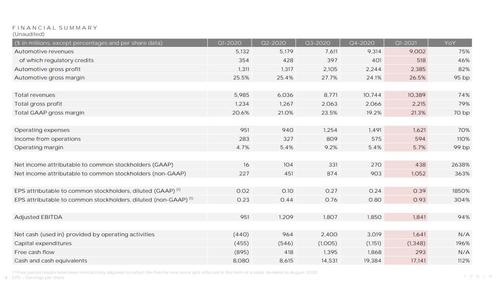
But here is the problem: TSLA
reported $594MM in income from operations, but regulatory credits
accounted for a whopping $518MM of it, the highest on record and up from
$401MM in Q4 2020.

So
while GAAP net income was just $438MM, this means that for yet another
quarter the company did not generate actual net income without
regulatory credits. Add that another $101MM in profits came from "sale
of bitcoin"...
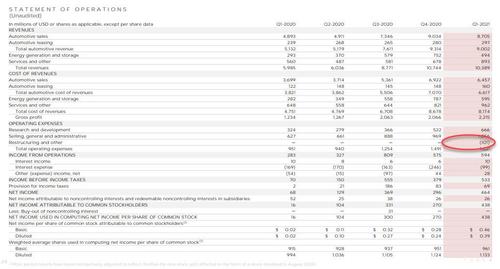
...
with TSLA owning $1.3BN in digital assets at the end of the quarter,
which means it sold around $272MM of the bitcoin it previously owned.
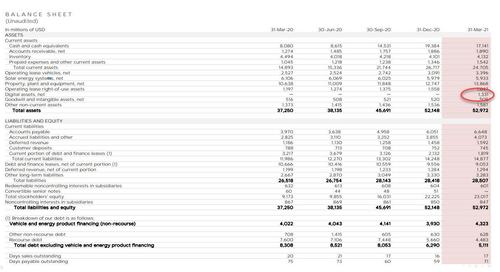
So in addition to over half a billion in reg credit sales, made $101MM in profits from sale of $272MM in bitcoin (reducing its total from $1.5BN to $1.331BN at the end of the quarter).
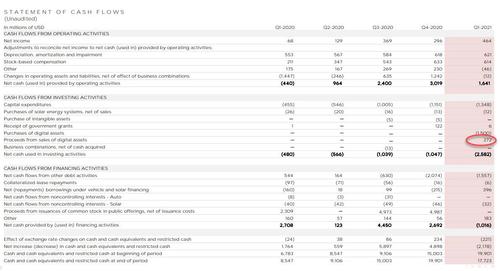
And while everyone assumes that this is all bitcoin, it is unclear how much of TSLA's "digital assets, net" was Dogecoin.
Of
course, some will claim that non of this matters, and that TSLA has in
fact generated 7 consecutive quarters of profits, although if one strips
reg credits from the GAAP Net Income, this is what one gets.
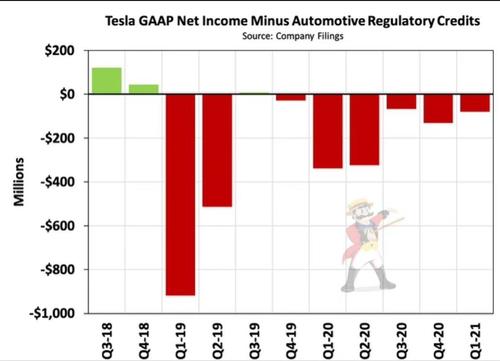
Discussing
its profitability, TSLA said that its operating income improved in Q1
compared to the same period last year to $594M, resulting in a 5.7%
operating margin. "This profit level was reached while incurring SBC
expense attributable to the 2018 CEO award of $299M in Q1, driven by an
increase in market capitalization and a new operational milestone
becoming probable."
On a year over year basis, Tesla said
that positive impacts from volume growth, regulatory credit revenue
growth, gross margin improvement driven by further produt cost
reducstions and sale of bitcoin were mainly offset by a lower ASP,
increased SBC, additional supply chain costs, R&D investments and
other items. Model S and Model X changeover costs negatively impacted
both gross profit as well as R&D expenses.
In terms of
Tesla’s financial performance, it’s a case of better-than-expected
Automotive Margins and free-cash-flow. The company said of its profit
outlook: "We expect our operating margin will continue to grow over
time, continuing to reach industry-leading levels with capacity
expansion and localization plans underway."
The company also
disclosed that it is on track to start production from Berlin factory in
2021, adding that first deliveries of the new model S should start
shortly.
On the cash flow side, TSLA revealed that it had a $1.2BN
net cash outflow related to bitcoin in Q1, as well as net debt
repayments of $1.2BN offset by free cash flow of $293MM, which was above
the estimate of $83MM in cash burn:
Quarter-end cash
and cash equivalents decreased to $17.1B in Q1, driven mainly by a net
cash outflow of $1.2B in cryptocurrency (Bitcoin) purchases, net debt
and finance lease repayments of $1.2B, partially offset by free cash
flow of $293M

Looking
ahead, Tesla said it expects to achieve 50% average annual growth in
vehicle deliveries over a multi-year horizon. But the company notes that
rate of growth will depend on equipment capacity, operational
efficiency and capacity and stability of supply chain.
Tesla’s timeline also remains largely intact. From the shareholder letter:
“We
are currently building Model Y capacity at Gigafactory Berlin and
Gigafactory Texas and remain on track to start production and deliveries
from each location in 2021. Gigafactory Shanghai will continue to
expand further over time. Tesla Semi deliveries will also begin in
2021.”
Something else the market may not like is
that the average selling point for a Tesla fell 13% in the first
quarter. According to the company, this is "because Model S and Model X
deliveries reduced in Q1 due to the product updates and as lower ASP
China-made vehicles became a larger percentage of our mix."
Elsewhere,
there was no substantive mention of Cybertruck anywhere in the
shareholder presentation, just that it’s a product ‘in development’
listed under the Texas plant. As Bloomberg reminds us, "Musk has said on
prior calls that small volumes of Cybertruck deliveries could be
possible by the end of this year. Will he give an update on that during
the earnings call?"
Not surprisingly, not even TSLA's usual
cheerleaders were ecstatic about the results: “Everything happened that
people thought would happen,” Munster told Bloomberg. “There’s not a lot of news and it wasn’t a blowout.”
* * *
In
kneejerk response to the earnings, Tesla shares were first up, but then
slide more than 1% in postmarket, which nonetheless was a much tamer
reaction than what options trading was pricing in ahead of the results.

